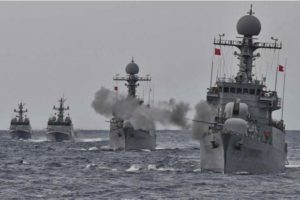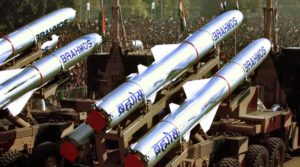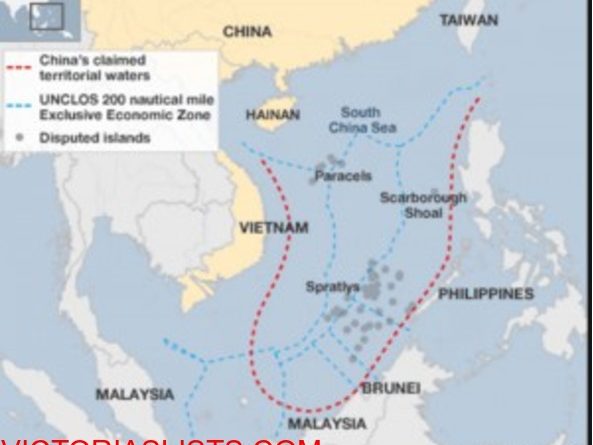Op-Ed : Asean military kits up for wider challenges – Opinion Manila Times


.
MILITARY arms procurement is evident in the Association of Southeast Asian Nations (Asean) member countries. Was it prompted by the increased tension in the South China Sea aggravated by threats of missile attack following a war of words between the US and North Korea? Of late, North Korea fired a ballistic missile over Japan described by Prime Minister Abe as “an unprecedented, serious and significant threat”.
Actually, challenges to Asean security have increased due to recent international and homegrown terrorists attacks prompting governments to be on extreme alert; border violence; internal disorders; displacement of people due to armed conflicts; maritime piracy; illegal, unreported and unregulated fishing and other marine-related environmental crimes; proliferation of narcotic drugs; entry of illegal aliens and contrabands; secessionist armies/insurgencies; and humanitarian assistance/disaster reliefs. Add to the enumeration the popularity of cyber warfare which gave way to various levels of uncertainty and a new perception about security concerns.
The arms procurement spree was further encouraged by exhibitors representing the whole supply chain with widely advertised demonstrations of most recent invented or developed warfare technologies cum conferences in Singapore, Thailand and Indonesia. Defense and security insight and information sources around the globe regularly report on the military modernization thrust of Asean countries as part of a serious Southeast Asian trend towards greater military capabilities.
Indonesia. The most complex warship ever to be assembled in Indonesia has successfully completed its sea trials validating the country’s ability to assemble more sophisticated warships beyond small surface combatants and support ships. The guided missile frigate Raden Eddy Martadinata, has been fitted to accommodate anti-air missile, anti-ship missile and torpedoes for anti-submarine warfare.
Jakarta is strengthening its maritime presence in the South China Sea against the backdrop of an increasingly robust stance by Beijing in the region. It is not a claimant to the SCS territorial disputes but China’s nine-dash-line claim overlaps with Indonesia’s exclusive economic zone. Hence, apart from the deployment of more ships, Indonesia plans to deploy unmanned aerial vehicles and additional personnel in the Natuna Islands area.
In addition, the Indonesian Air Force has received four refurbished F-16 combat aircrafts from the United States. The six aircraft are still to be delivered and are in various stages of regeneration/modification.
Indonesia maintains a submarine base in Sulawesi Island.
Malaysia. The Asean trend for military equipment acquisition is also true in the Royal Malaysian Air Force’s program to procure military transport aircraft and multi-role combat aircraft as part of its military lift requirements. In fact, a handover of four military transport aircraft was made in March 2017 for military and humanitarian operations within Malaysia and the region.
The Royal Malaysian Navy, on the other hand, has a program to build littoral mission ships (LMS) to boost the Malaysian shipbuilding industry. An LMS can be armed with naval gun in a remote-controlled weapon station turret as primary weapon. The platform can carry one containerized mission module on deck. This gives the ship flexibility to be utilized for missions including search and rescue, humanitarian assistance and disaster relief and maritime surveillance operations.
Philippines. The last few years saw the ‘golden age’ of the Philippine Navy (PN) in terms of the service’s modernization. The sealift vessel BRP Tarlac, the largest ship to be operated by the PN to date, significantly improved the country’s humanitarian assistance and disaster relief capabilities. It also proved itself a counter-insurgency platform when it was deployed to the Southern Philippines as a special forces forward operating base against the Abu Sayyaf Group.
The PN fleet was further boosted by the donation of three ex-US Coast Guard security cutters to improve the country’s maritime constabulary capabilities. It is also set to receive from the US a radar system to enhance capability in maritime intelligence surveillance and reconnaissance by effectively detecting maritime and air traffic within the country’s coastal waters paving the way for an innovative radar solution to counter threats.
The Philippine Coast Guard (PCG), on the other hand, has commissioned a fleet of patrol vessels and boats. Anticipated is the delivery of PCGs largest ship to date – an 82m offshore patrol vessel from France. The new assets will be deployed to the southern region plagued by maritime piracy and insurgency incidents.
The Bureau of Fisheries and Aquatic Resources received two new indigenously built seacraft in the category of multi-mission offshore vessels to protect the Philippine waters against illegal fishing and for research activities and disaster relief/rescue operations as well.
Mention should also be made that the Philippine Air Force has taken formal delivery of two Korean advanced jet trainer/light attack aircraft with more coming by the end of 2017.
More weapons system and ammunitions mean increased need for manpower. The government is looking forward to enlisting more officers and accept more enlisted personnel to meet its manpower needs.
Singapore. Among Asean countries, Singapore has gone farthest in military modernization efforts. Singapore now operates a range of indigenously developed and imported platforms and technologies which elicited awe at its Army Open House 2017 event. Started in 2014, the Singapore Armed Forces (SAF) transformation program is acknowledged as having structured an advanced and highly integrated fighting force capable of responding to all imaginable threats.
The “new generation SAF” designed to address 21st century threats includes, but is not limited to: a) protected combat support vehicle designed to provide logistics support to frontline combat units in place of vulnerable soft-skinned trucks; b) main battle tanks with new sighting system in lieu of the original series of primary panoramic sight; c) protected mobility vehicle equipped with a five-mode differential lock system and an integral central tire inflation system for improved mobility over difficult terrain, while run-flat tires ensure continued operation even with multiple punctures; d) combat ambulance which is cross-country capable and optionally armored; e) autonomous underwater robot capable of providing high quality seabed data for mine countermeasure operations; and f) a prototype tracked armored recovery vehicle to provide repair and recovery support to armored fighting vehicles. All this will provide the armed forces with enhanced firepower, protection, mobility and situational awareness.
Within Asean, Singapore’s is the only navy with a rescue ship that is capable of conducting a collective rescue. It is currently engaged in exercises with partner navies designed to widen submarine safety and interoperability.
Thailand. The Royal Thai Army recently approved the procurement of 10 main battle tanks from China. The ordered vehicles will feature cannon, machine gun and anti-tank guided weapon system. Meantime, the Royal Thai Air Force will procure additional lead-in fighter trainer aircrafts from Korea.
Additionally, in its national effort to enhance self-sufficiency, the Thai government outlined a commitment to develop national shipbuilding capabilities to support modernization of the Royal Thai Navy including a plan to procure diesel-electric submarines from China.
Since the military coup in 2014, Thailand’s submarine plan won greater public support on account of the fact that the country needs to maintain military balance with its Asean neighbors many of which have invested heavily in acquiring subsurface capabilities.
Brunei Darussalam. The country’s manifest cooperation with Asean’s military preparedness is evidenced by its navy’s project in building a center of excellence for seamanship warfare, weapons handling, fire fighting and damage control, communications and engineering training. Brunei’s German-made off shore patrol vessels have considerably enhanced its navy’s capabilities.
Myanmar. Myanmar received eight Chinese frigates under its development of naval industries capabilities program in conjunction with China. The rapid expansion of Myanmar’s Navy backed up by an ambitious program of indigenous shipbuilding is well noted in the region. Myanmar’s military, or Tatmadaw, however, was drawn into a long and costly military campaigns against insurgents in the Kokang region of the northeastern Shah State. The Kokang campaign marked the first time the Tatmadaw undertook combined arms operations involving mechanized infantry, artillery, armor and air power under combat conditions.
A recent surge in violence was reported in troubled Rakhine state vis-à-vis the Rohingya Muslim minority who are perceived as illegal immigrants in Buddhist-majority Myanmar.
Vietnam. As Vietnam’s economy improves tremendously, reforms to further professionalize the Vietnam People’s Army are under way. Its procurements include, among others, fighter aircrafts, submarines, coastal radar system, maritime patrol helicopters and fast patrol vessels for the Vietnam Coast Guard.
Early this year, Russia delivered five diesel-electric submarines ordered by Vietnam whose coastal defense systems are equipped with Russian-made arsenals. Expected before the end of 2017 is delivery of multi-combat JF-17 fighter aircrafts which feature an air-to-air refueling capability and improved avionics and electronics.
The US has lifted its longstanding military embargo on Vietnam in order to support Hanoi’s efforts to respond to the growing regional tensions.
Cambodia. In a bid to enhance bilateral ties and to boost the country’s military capabilities, Cambodia was recently provided by South Korea with military vehicles as part of an ongoing military aid package program. It consists of military trucks, engineering vehicles and river patrol vessels.
A border dispute with landlocked Laos is expected to be amicably settled.
Be that as it may, the most pressing priority for Asean countries in the widened security challenges is to improve their intelligence-gathering capabilities. Procurement of munitions alone will not suffice. There ought to be improvement in the region’s intelligence-sharing and coordinating capabilities. More than any other time, the new era of “intel-centric” warfare using innovative information, communications and computer technologies demands the ability to assess, analyze and decisively act in an emerging situation of critical importance. In short, military equipment and weapons advantage should be backed by an effective intelligence capability.
Indeed, a lot still has to be done. Among these are: a) a review of each state’s responsiveness to defend itself against threats to national security; b) establishment of effective capability pooling; c) collaborative defense research and development; and d) an Asean defense industry complex. In all this, there is a strong imperative for more efficiency, more consultation, more coordination and more cooperation among the Asean military to create the assurance about the region’s self-defense readiness.
NOTE : All photographs, news, editorials, opinions, information, data, others have been taken from the Internet ..aseanews.net |
[email protected] |
For comments, Email to : [email protected] – Contributor










